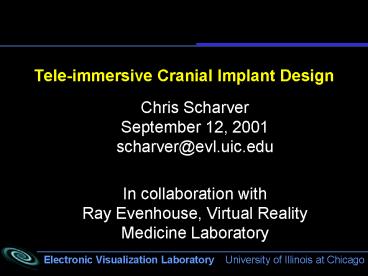Tele-immersive Cranial Implant Design - PowerPoint PPT Presentation
1 / 19
Title:
Tele-immersive Cranial Implant Design
Description:
Tele-immersive Cranial Implant Design Chris Scharver September 12, 2001 scharver_at_evl.uic.edu ... What aspects of tele-immersion are important to this usage? – PowerPoint PPT presentation
Number of Views:118
Avg rating:3.0/5.0
Title: Tele-immersive Cranial Implant Design
1
Tele-immersive Cranial Implant Design
- Chris ScharverSeptember 12, 2001scharver_at_evl.uic
.edu - In collaboration withRay Evenhouse, Virtual
Reality Medicine Laboratory
2
Cranial Prosthetics
- Images from the current process
- Before image
- Magnetic resonance imaging-based model
- Stereo lithography model,
- After image
3
Problem Statement
Tele-immersive tools will allow cheaper and more
rapid prototyping and evaluation of cranial
prosthetic implants than clay and polymer
modeling techniques.
4
Current Surgical Method
- Magnetic resonance scan of patient
- Stereo lithography model of defect
- Defect sculpted with clay
- Defect cast
- Implant modeled with dental wax
- Implant cast
- Surgery and implantation
- Very expensive!
5
Jim Foleys Top Ten (2000)
- Top ten problems in computer graphics
- Updated list at Vision 2000
- 9 User interfaces for creativity
6
Immersive Modeling
- CHIMP Chapel Hill Immersive Modeling Program
(UNC) - Architecture
- http//www.cs.unc.edu/mine/chimp.html
- Samuel (Fraunhofer-Gesellschaft)
- General use
- http//vr.iao.fhg.de/imodeling/samuel.en.html
7
Skull Model
- Theoretically obtained from MRI data, then
converted into geometry for loading into scene
graph - Manually made from the Visible Human data set
8
Hardware Setup
- PHANToM haptic device
- 6DOF position and rotation
- 3DOF force feedback
- Tracking system
- Display device
- Immersive display?
- Would a monitor suffice?
9
PARIS
- Prototyped using the CAVE
- Hands are visiblethrough the displayscreen
throughthe use of ahalf-silveredmirror screen - Tracking issimilar to anImmersaDesk
10
Software
- PHANToM
- GHOST API, NT driver only
- Interface with trackd SDK?
- Display and scene graph
- GHOST provides geometry and properties
- OpenSG, Open Inventor, TGS Inventor 3.0,
Performer? - Additional libraries
- VTK, geolib, NURBS, CAVERNsoft
11
e-Touch 3D
- Open module API and building tool
- NT and Solaris
- OpenGL
- GHOST SDK support
- CAVELib, trackd, and support for other platforms?
12
Defect Specification
- Outline with connect the dots
- Intersection testing
- Performer provides the ray casting
- Draping algorithms
- Volumetric collision detection
13
Modeling Method?
- Parametric surfaces
- Non-Uniform Rational B-Splines (NURBS)
- These are surfaces, not volumes
- Constructive solid geometry
- Most algorithm implement only primitives
- Implementation with polygons more difficult
- Metaballs
- Blobby modeling
- Already used for haptic clay applications
14
Input from Artists
- Constraints
- Implant must be separate piece
- Cannot simply copy and paste the other side
- Minute refinement is required
- What kinds of tools would you use?
- How would you apply 2D modeling tools to a
tele-immersive environment?
15
Collaborative Modeling?
- Mutual exclusions in interaction
- Communication between the participants
- Likely only one haptic user
- Audio conferencing
- Evaluation methods
- Photographs of patient
- Side by side comparisons
- Overlays
- Teacher-student paradigm
16
Thesis Concentration
- Not trying to create the ultimate modeling
package! - What aspects of tele-immersion are important to
this usage? - Is it worth using these technologies in this
manner? - What are the benefits and pitfalls?
17
General Time Frame
- September-October
- Install libraries, hook up hardware
- Determine incompatibilities
- October-February
- Interaction and modeling programming
- February-May
- Testing, evaluation, refinement
- Retesting
18
Possible Consequences
- Patient is not required to travel hundreds of
miles until the surgury is planned - Cost of production is significantly lower than
the current process - Tangible and quantifiablecontribution of virtual
realitytechnology to medicine.
19
Credits
- http//www.bvis.uic.edu/VRML/Research/CranialImpla
nts/CranialImplants01.htm - http//www.evl.uic.edu/images/research/PARIS2.jpg
- http//www.sensable.com/
- http//www.etouch3d.org/etouch.htm































